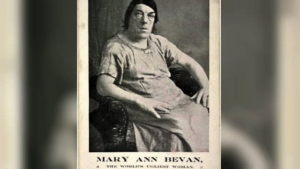In the 19th century, “human curiosities” were among the most popular attractions, seen as a normal part of American society.

These were essentially traveling circuses that exhibited “unusual” individuals, such as bearded women and Siamese twins. Mary Ann Bevan, one of these “curiosities,” was dubbed the “Ugliest Woman in the World,” and her life story sheds light on the exploitation faced by such individuals.
People with different ethnicities or physical characteristics have always fascinated others, but profiting from their exhibition is morally wrong, regardless of the era.

During the 19th century, crowds flocked to see people with deformities, but today, such exploitation is unthinkable. The popularity of “human curiosities” peaked from the 1840s to the 1940s, with profiting from exploitation deemed acceptable.
Hence, it’s no surprise that Mary Ann Bevan’s story unfolded during this period. Born on December 20, 1874, in Plaistow, East London, United Kingdom, Mary Ann Webster grew up in a typical working-class family.

After marrying Thomas Bevan in 1902 and having four children, Mary Ann faced tragedy when Thomas passed away after 14 years of marriage. Left to support her family alone, Mary Ann also began experiencing physical health issues.
Around the age of 32, Mary Ann began showing symptoms of acromegaly, a rare condition that caused her facial features to distort and enlarge, making her unrecognizable from her former self.

Unfortunately, medical understanding of acromegaly was limited at the time, and Mary Ann struggled to find help for her condition. With her appearance drastically changed, finding employment to support her family became challenging.
In her desperation to provide for her children, Mary Ann responded to a newspaper advertisement seeking the “ugliest woman.” This led her to join a circus in America, where she became known as “The Ugliest Woman on Earth” and earned a substantial income.

Despite her financial success, Mary Ann endured mockery and exploitation from circus organizers and audiences alike. Nevertheless, she persisted in ensuring her children received a good education and a brighter future.
Mary Ann passed away in 1933, leaving behind a legacy of sacrifice and love for her family. Her story serves as a poignant reminder of the resilience of the human spirit and a mother’s unwavering devotion to her children.
Rest in peace, Mary Ann Bevan. Your selflessness and determination will forever be remembered.





